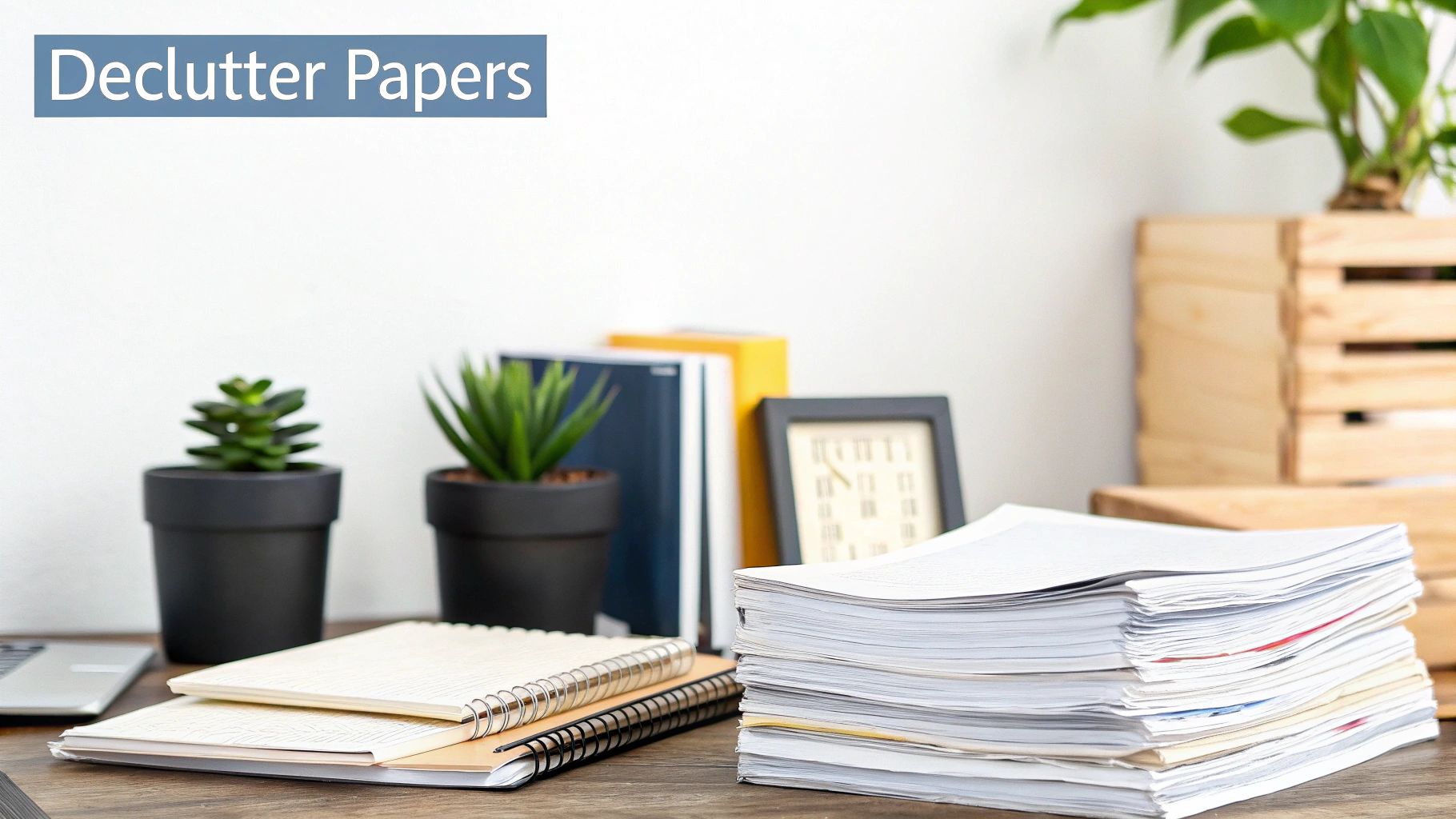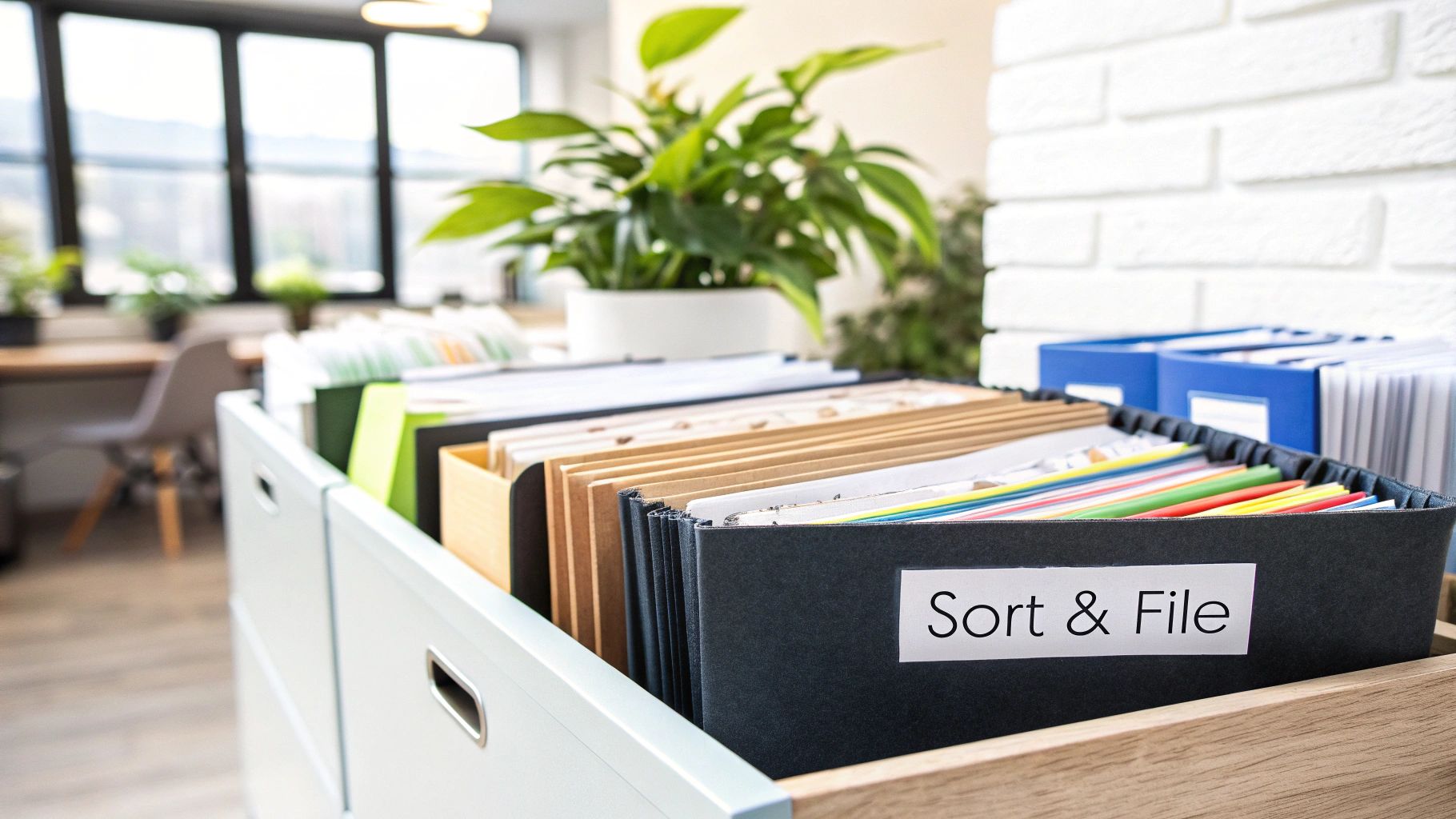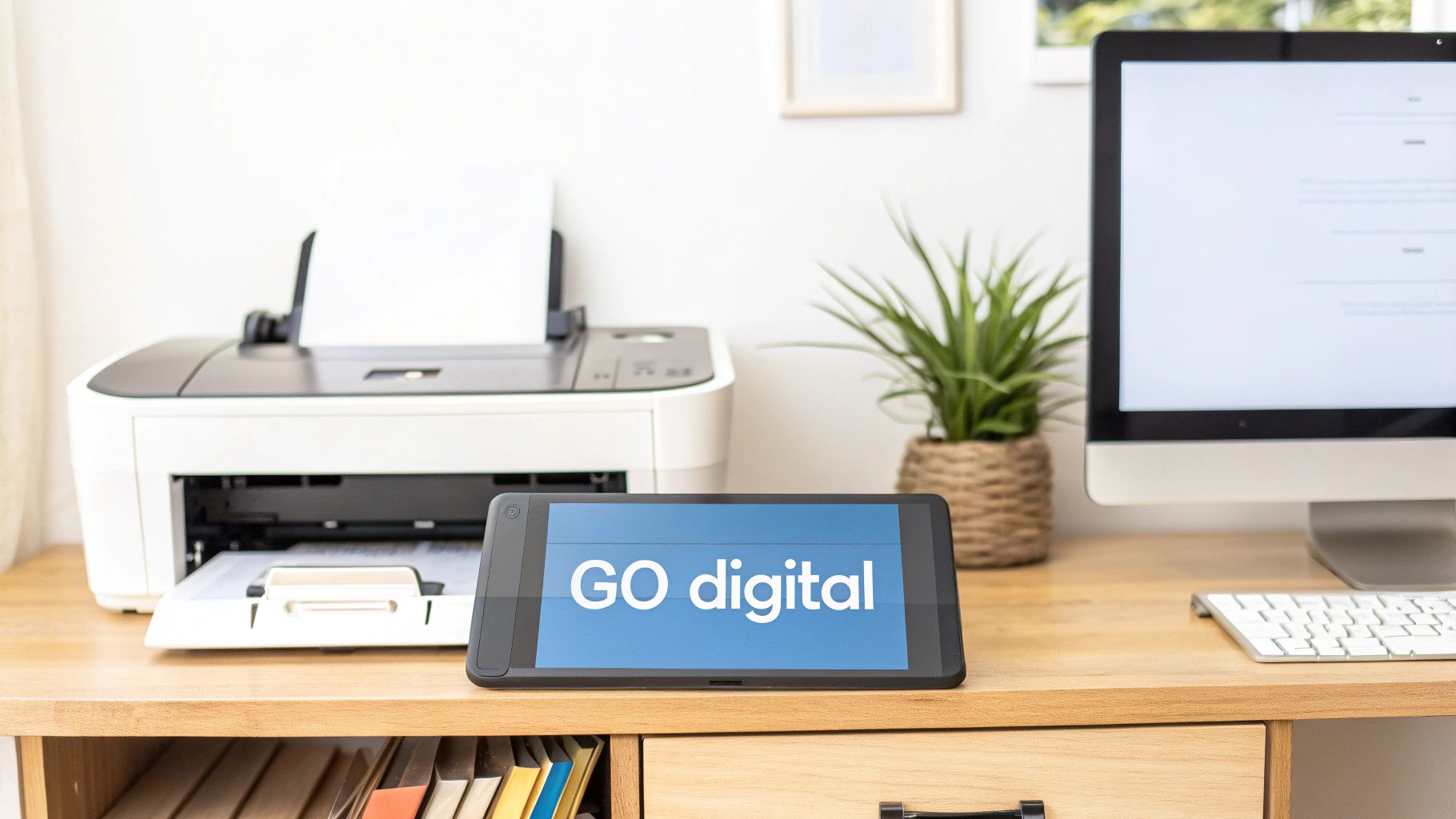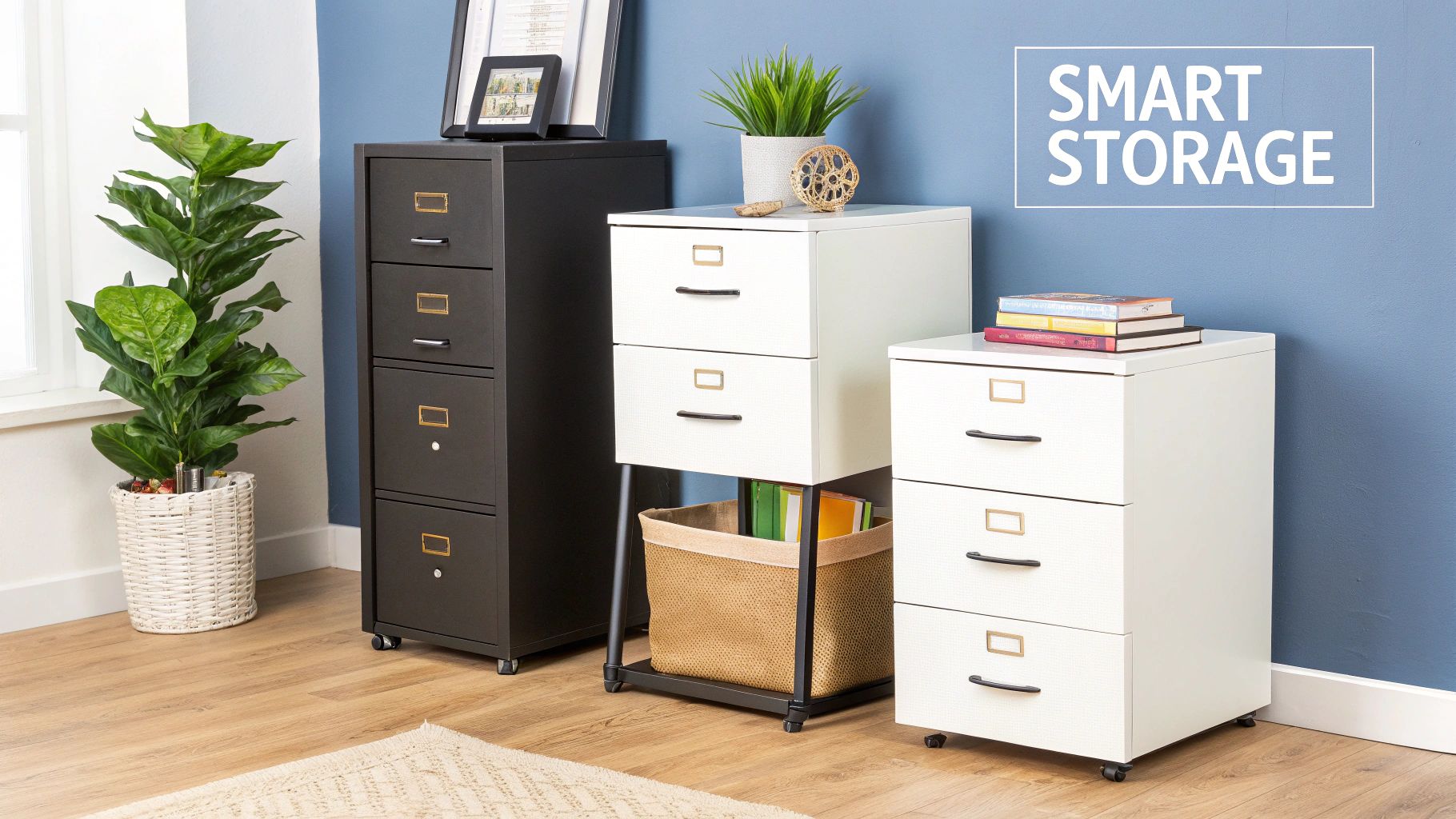Why Paper Chaos Is Costing You More Than You Think
That precarious stack of papers on your kitchen counter? The overflowing file drawer that’s become a no-go zone? It’s more than just an eyesore. It’s a hidden cost, impacting your time, energy, and finances. We often overlook the true consequences of disorganization, fixating on the visual clutter instead of the wider impact. However, a disorganized paper system can significantly affect our daily lives.
Think about the wasted time hunting for a crucial document. Late fees from misplaced bills, the stress of lost tax documents, and the frantic search for important medical records. These “search-and-rescue” missions add up, stealing valuable hours of productivity. Furthermore, visual clutter itself increases stress hormones, making it harder to relax and focus. It’s a constant, low-hum of anxiety in the background.
This isn’t just a personal anecdote; it’s a common struggle. The sheer volume of paperwork we accumulate is a major contributor. In the U.S. alone, over 4 trillion paper documents exist, and this number grows by 22% each year. Find more detailed statistics here. These document-related issues can cause roughly 21.3% productivity loss. The average office worker spends around $120 in labor just searching for a single misplaced document! How to master your archive. This highlights the need for efficient paperwork management. The cost of paper chaos clearly extends beyond a messy desk.
The Mental Toll of Clutter
Beyond the financial and time costs, disorganization takes a mental toll. Studies link clutter to increased stress, anxiety, and feelings of being overwhelmed. Our brains crave order. Surrounding ourselves with chaos hinders focus and decision-making. It’s like running a marathon with ankle weights. Even highly successful professionals grapple with paper management, demonstrating that it’s a universal challenge.
Reclaiming Control: The Benefits of Organization
Conquering paper clutter isn’t about aesthetics; it’s about regaining control of your time, mental space, and life. Imagine finding any document instantly, paying bills on time, and enjoying a workspace that inspires calm, not stress. That’s the power of an organized paper system. It creates a ripple effect of productivity and peace throughout your home.
By implementing effective organizational strategies, you’ll create a home that is not just functional but also peaceful and productive.

Creating Your Paperwork Command Center
Transforming a corner of your home into a practical paperwork command center is crucial for managing paper clutter. The focus shouldn’t be on creating a showroom-worthy space, but rather a system that integrates seamlessly with your lifestyle. Prioritize functionality over aesthetics. This means selecting a spot that encourages consistent use. A dedicated home office is perfect, but a kitchen drawer or a small countertop section can work just as well. The core principle is easy access and convenience.
Choosing the Right Location
Consider your daily routines. Where do you typically sort mail or pay bills? Placing your command center near these areas promotes regular use. For instance, if you open mail in the kitchen, consider a nearby drawer or shelf. If you prefer working in a home office, dedicate a specific area on your desk. The goal is to incorporate paperwork management into your existing workflow.
Essential Tools and Supplies
Investing in the right tools can significantly improve your organization process. While attractive organizers might be tempting, prioritize functionality. Here’s a list of essential items:
- A high-quality shredder: This is vital for securely disposing of confidential documents.
- File folders: Select durable folders that can handle frequent use. Color-coding can further enhance your system.
- Labels: Clear, concise labels help you find what you need quickly.
- Storage containers: These can range from basic file boxes to more complex filing cabinets. Choose options that fit your space and budget.
To help you visualize the essentials, take a look at this comparison table:
Essential Paperwork Organization Supplies: A comprehensive comparison of must-have supplies for creating an effective home paperwork management system
| Item | Purpose | Estimated Cost | Importance Level |
|---|---|---|---|
| High-quality shredder | Securely dispose of sensitive documents | $50 – $200 | High |
| File folders | Organize and categorize documents | $5 – $20 per pack | High |
| Labels | Clearly identify file contents | $5 – $15 per pack | Medium |
| Storage containers (file boxes, filing cabinets) | Store and protect organized documents | $10 – $200+ | High |
This table highlights the cost and importance of each item, allowing you to prioritize your purchases based on your needs and budget. A good shredder and reliable storage solutions are critical for secure and efficient document management.
Arranging for Maximum Efficiency
After selecting your location and gathering your supplies, arrange your command center for maximum efficiency. Place frequently used items within easy reach. Think of it like a chef’s mise en place – everything has its designated place. This minimizes wasted time searching for supplies.
Creating a Visually Appealing System
While functionality is paramount, aesthetics also matter. A visually pleasing system is more likely to be maintained. This doesn’t require spending a fortune on designer organizers. Simple touches, like using coordinating colors or decorative labels, can make a big difference. This creates a sense of pride and encourages you to keep your system tidy. Adding personal touches can make organizing more enjoyable.

The U.S. Home Organization Products market, valued at USD 11.79 billion in 2023, is projected to reach USD 16.15 billion by 2030, demonstrating a CAGR of 4.6%. This growth highlights the increasing importance of organized living spaces, particularly for managing paperwork. Find more detailed statistics here. Understanding potential downsides is also important. You can learn more about financial risk assessment.
Designing a Filing System You’ll Actually Use
Moving beyond simply gathering supplies, the real key to organizing paperwork at home is designing a system that works for you. Forget generic advice! Think about your habits and personality. Are you a visual person who loves color-coding? Or a minimalist who prefers simple labels? Figuring out your organizational style is the first step to creating a system you can stick with. For example, a portable accordion file might be more practical than a bulky filing cabinet if you’re always on the go. This personalized approach sets you up for success.

Understanding Your Organizational Style
Just like homes, organizational styles are unique. Some thrive on detailed systems, others prefer a simpler approach. Neither is wrong. Self-awareness is key. Ask yourself: Do I prefer digital or physical systems? How detailed do I want to be? How much time can I realistically spend on upkeep? Honest answers will help you find a system that works. Check out this helpful resource: How to master categories. This thoughtful introspection sets the foundation for a sustainable, personalized system.
Practical Labeling Techniques
Once you’ve defined your style, focus on labeling. Clear, concise labels are essential. Avoid vague terms like “Miscellaneous.” This often becomes a catch-all for unorganized papers. Instead, use action-oriented labels, like “Bills to Pay” or “Receipts 2024.” Consider color-coding for visual organization. Even shades or patterns can be effective for those with color-blindness. Clear labels and visual cues will transform your filing system into a well-organized resource.
Clever Category Structures
A logical category structure is crucial for any filing system. Think about the paperwork you handle regularly. Common categories include finances, medical, household, and personal. Create subcategories within these broader groups, like “Utilities,” “Insurance,” or “Warranties.” This hierarchy makes finding documents easy. Designate a separate area for sentimental items, keeping them apart from active documents. This prevents important papers from getting lost. Don’t underestimate the psychological benefits of an organized space. Clutter can increase stress. Studies show that organizing can reduce stress and improve mental health. Discover more insights about professional organizing.
Physical Filing Solutions
Finally, choose your physical storage. Traditional filing cabinets are great for large volumes of paper, while portable file boxes offer flexibility. Wall-mounted organizers or under-desk drawers are great space-saving options. Choose solutions that fit your home’s aesthetic. This makes maintaining an organized system much easier. The right storage combined with a personalized system transforms paperwork management from a chore to a sustainable habit.
The Paper-Taming Workflow That Never Fails

So, you’ve designed your perfect filing system. Great! Now, let’s talk about the everyday habits that will keep those papers from piling up. The trick? Handle each piece of paper only once. This simple rule stops paper mountains before they even begin. Think of your paperwork like a well-oiled machine: each document has a designated place and purpose.
The OHIO Method: Only Handle It Once
Professional organizers love the OHIO (Only Handle It Once) method. It’s all about making quick decisions about every piece of paper that comes your way. Instead of tossing mail onto a “to-do” pile, deal with it right away. Trash it, file it, or take action immediately.
This small change prevents papers from endlessly circulating. You’ll spend less time sorting and reshuffling, and more time on things you enjoy.
Creating Decision Triggers
The OHIO method works best with decision triggers. These are pre-planned actions for each type of document. A bill? Pay it now or schedule the payment. A receipt? File it in your Evernote expense tracker. These triggers streamline paper processing, making it almost automatic.
No more agonizing over what to do with each piece of paper – it’s already decided!
Realistic Routines for Busy Schedules
Even the best system needs to fit your life. Setting aside just 15 minutes each day for paperwork can make a big difference. Or, block off a longer chunk of time weekly – maybe Sunday evenings – for a more thorough review. Find a rhythm that works for you, and stick with it. This way, paperwork becomes a routine, not a dreaded chore.
Addressing the Emotional Side of Paper
Paperwork can be surprisingly emotional. Sentimental attachments, fear of mistakes, or feeling overwhelmed can create mental blocks. Recognizing these feelings is the first step to overcoming them. This self-awareness helps you build a system that truly works, making you feel more in control. Being able to quickly find important documents can reduce stress and promote a sense of calm.
Document Retention: When to Let Go
Knowing how long to keep documents is key for an efficient system. It helps you avoid unnecessary clutter and gives you peace of mind.
Here’s a handy table to guide you:
Document Retention Guidelines: A reference table showing how long to keep different types of documents before securely disposing of them
| Document Type | Retention Period | Storage Recommendation | Disposal Method |
|---|---|---|---|
| Tax Returns | 7 years | Secure file cabinet or digital storage | Shred |
| Bank Statements | 1 year (unless needed for taxes) | File folder or digital storage | Shred |
| Utility Bills | 1 year | File folder or digital storage | Recycle |
| Pay Stubs | 1 year | File folder or digital storage | Shred |
| Medical Records | Varies (consult with healthcare provider) | Secure file cabinet or digital storage | Shred |
This table offers some basic guidelines. Always check official recommendations for specific document types. This keeps your system efficient and ensures you’re meeting all requirements. Using these strategies will address both the practical and emotional challenges of paper management, leading to a less stressful and more organized life.
Going Digital: Smart Tech Solutions For Paper Overload
Drowning in paperwork? Switching to a digital system offers a powerful way to tackle overflowing filing cabinets. Not only does digitizing documents reduce clutter, it also simplifies retrieving information. This isn’t just for the tech-savvy; there are practical digital solutions available for everyone, no matter their comfort level with technology. You can build a system perfect for your needs, from simple scanning apps to robust cloud storage solutions.
Choosing The Right Scanning Method
The first step to going digital is deciding how you’ll capture your documents. For occasional scanning, a mobile scanning app might be sufficient. Many apps offer features like Optical Character Recognition (OCR), which transforms scanned images into searchable text.
This is incredibly useful when searching for specific information later on. For example, searching for “electricity bill” will locate the file, even if the filename is generic. Added features like automatic shadow removal and crease flattening help ensure you have clear, legible digital copies. For large volumes of paper, a dedicated document scanner might be a better investment. These offer faster speeds and superior quality scans. Think about your specific needs and budget when making your selection.
Building A Digital Filing System
Just like a physical filing cabinet, your digital system needs organization. Create clearly labeled folders and subfolders that reflect your existing paper categories. For example, a main folder named “Finances” could include subfolders for “Taxes,” “Bills,” and “Investments.”
Descriptive filenames are also crucial for quick retrieval. Name a file “Electricity Bill – January 2024” rather than something vague like “Bill1.” This small detail will save you time later. Consider how to master tagging to boost your digital organization. Just like physical files, regular maintenance is important. Regularly review your digital files and delete anything outdated to prevent digital clutter.
Exploring Cloud Storage Options
Cloud storage services like Google Drive, Dropbox, and iCloud offer secure and accessible ways to store digital documents. These services offer automatic backups and allow access to your files from anywhere with an internet connection.
However, security is a key consideration. Enable two-factor authentication for an extra layer of protection. This requires a second verification method, such as a code sent to your phone, making unauthorized access much harder. Also, pick a service that encrypts your data both in transit and at rest. This ensures your files are protected even if someone gains access to the server.
Is It Worth Scanning Everything?
Going digital has advantages, but not every document needs scanning. Focus on documents you access regularly or need for legal or financial purposes. This could include receipts, bills, tax documents, and important contracts.
Sentimental items like children’s artwork or handwritten letters can be scanned, but the originals can be kept if space allows. This approach lets you experience the benefits of going digital without needing to scan every single piece of paper.
Overcoming Digitization Challenges
Digitization does have its challenges. Concerns about privacy, security, and the longevity of digital files are common. However, taking the right steps can address these issues. Back up your files regularly to both the cloud and an external hard drive.
This redundancy protects your information from data loss or service disruptions. Also, understand the terms of service of your cloud storage provider. Make sure they meet your privacy expectations. By addressing these challenges head-on, you can confidently enjoy the benefits of a digital filing system, making your paper overload a streamlined, easily accessible archive.
Maintaining Your System When Life Gets Messy
Life has a way of throwing us off track. Even with the best-laid plans, our paperwork systems can become overwhelmed by unexpected events, busy schedules, or just the everyday influx of documents. Maintaining an organized system doesn’t require constant vigilance. It’s about creating manageable habits and having a plan for when things inevitably get a little chaotic. This way, your paperwork organization becomes a source of order, not another stressor.
Building Maintenance Routines That Stick
The secret to long-term organization success is incorporating small, regular actions into your daily life. Just like making time to brush your teeth, setting aside even 15 minutes a day to sort mail and file papers can prevent massive paper piles from accumulating.
For instance, deal with mail as soon as it arrives. Discard junk mail immediately and file important documents right away. This prevents small tasks from becoming overwhelming. This “touch-it-once” method ultimately saves time and mental energy.
Effective Recovery Strategies When Your System Slips
We all have moments where we fall behind. Sometimes, life just happens. Don’t get discouraged! Instead of feeling overwhelmed, look at these times as opportunities to fine-tune your system. Identify the early warning signs that your organization system is starting to slip. Is mail piling up on the kitchen counter? Is your filing cabinet overflowing? Recognizing these signs allows you to take action quickly, preventing a complete organizational meltdown.
When your system does slip, begin with a small, achievable task. Maybe tackle one specific category of documents or clear off one surface. This creates a sense of accomplishment and motivates you to keep going. Remember, progress, not perfection, is what matters. Just as a gardener regularly weeds a garden, periodically purging unnecessary paperwork helps your system stay efficient.
Involving Reluctant Family Members
Getting your family involved can greatly improve the success of your organizational system. However, it’s normal to face some resistance. Instead of imposing a rigid set of rules, involve family members in designing the system. Ask for their input on categories, labels, and storage solutions.
This collaborative approach encourages buy-in and makes everyone feel more invested in maintaining the system. Assigning specific responsibilities can also be helpful. Perhaps one person is in charge of incoming mail, while another handles filing receipts. Shared responsibility distributes the workload and fosters teamwork.
Adapting Your System to Life’s Changes
Life is a constant state of change. Your paperwork system should be flexible enough to adapt along with it. Major life transitions, like moving or changing jobs, often require adjustments to your system. Seasonal increases in paperwork, such as during tax season or back-to-school, may also require temporary modifications.
Look at these changes as opportunities to refine and improve your system, ensuring it stays relevant to your current needs. Think of your system as a dynamic tool, not a rigid structure. You might switch to a digital system like Evernote for some documents or set up temporary holding areas for seasonal paperwork. This creates a sustainable solution that simplifies your life, no matter what life throws your way.
Ready to create a more organized and peaceful home? Visit LAMU for a wide array of quality home organizers and storage solutions that will help you conquer clutter and create the calm, productive home environment you deserve.








Leave a comment